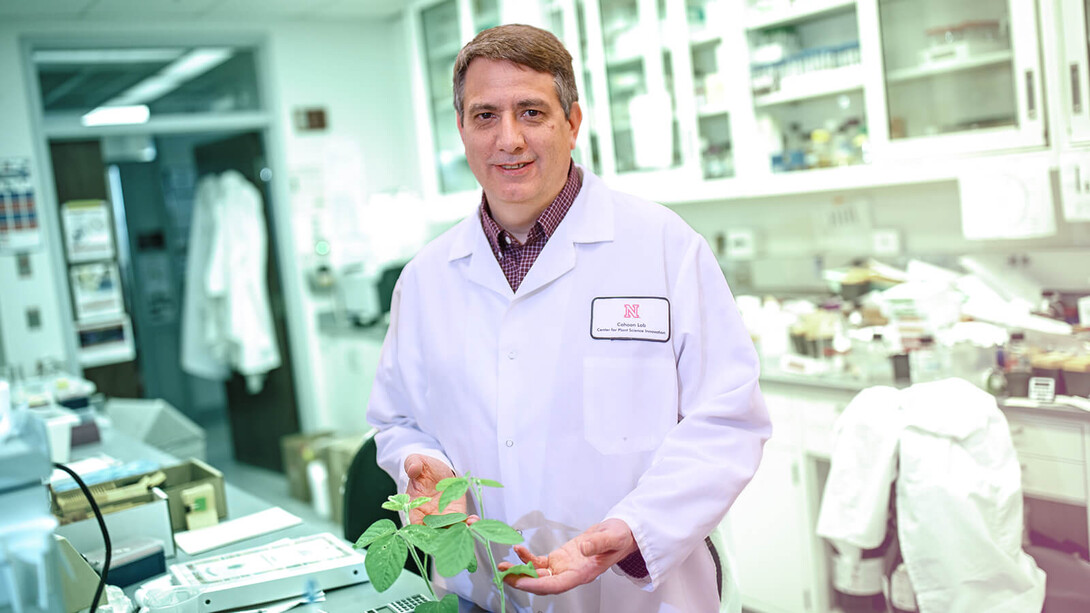
Lincoln, Neb. —A team of researchers including a University of Nebraska-Lincoln biochemist has developed a low-cost process to produce pheromones and enable the next generation of pest control. The findings facilitate environmentally friendly methods to protect food crops currently facing increased vulnerability to insect attack.
Pheromones are a viable environmentally friendly alternative to conventional insecticides for pest control. Pheromone-based pest control products have been restricted to high-value crops, however, as today’s manufacturing processes cannot yet produce pheromones at low enough costs to enable their use for lower-value crops, especially commodity row crops such as corn, soy and cotton.
The research team including Ed Cahoon, a UNL professor of biochemistry and director of the university’s Center for Plant Science Innovation, has developed a novel path to produce significant amounts of inexpensive pheromones from the ancient Viking seed oil plant Camelina. The project demonstrates the biological efficacy and economic feasibility of pheromone production in plant factories by metabolic engineering of an oilseed crop.
“Plant-based production of pheromones can provide growers with sustainable pest controls that are badly needed,” said Cahoon, the George W. Holmes professor with UNL’s Department of Biochemistry. That’s especially the case “now that global agriculture faces increasing pest resistance that renders conventional insecticides less effective and increasing pressure from governments and consumers demanding ever safer and greener food production.”
The research team also included scientists from Lund University in Sweden, the Swedish University of Agricultural Sciences and ISCA, Inc., a green ag-tech company based in Riverside, California. The scientists recently published their findings in the journal Nature Sustainability.
By modifying the genetic code of plants to express genes of insects and other organisms that guide the biosynthesis of the desired pheromones, the researchers created plants that produce insect pheromone precursor compounds in their abundant seed oil.
The team successfully grew Camelina sativa or Camelina seeds genetically modified to make (Z)-11-hexadecenoic acid, a sex pheromone precursor of several moth species, to provide the oil from which the precursor was isolated, purified and transformed into the final pheromone.
The scientists analyzed trap lures and mating disruption formulations containing this plant-derived pheromone, assessing their capacity to manage moth pests in the field. Plant-derived pheromone lures proved equally effective as synthetic pheromone lures in monitoring the diamondback moth, Plutella xylostella, in cabbage, and in disrupting mating of cotton bollworm moth, Helicoverpa armigera, in common bean fields.
Diamondback moth devastates brassica crops like cabbage and mustard around the world and has become resistant to most insecticides. Cotton bollworm similarly is highly resistant to conventional and biological insecticides and is a major worldwide pest species that causes hundreds of millions of dollars annually in damage to cotton, soy, corn, tomato, beans, chickpea and other crops.
Pheromones are among the next generation of insect controls because they protect crops by manipulating the behavior of problem insects, such as by preventing them from mating, by mass trapping or by luring them away from crops. Unlike conventional insecticides, pheromone controls affect only the targeted pest species, leaving beneficial pollinators and other wildlife unharmed. In addition, pheromones do not leave harmful residues on food produced, cause no environmental pollution and are far less prone to developing pest resistance.
The costs of synthesizing pheromones, however, have limited their application. By having plants do most of the synthesis work, pheromone production costs will be slashed. Biosynthesis in plants also eliminates the need to use petroleum-based chemicals as feedstock and bypasses most of the complex organic chemistry steps now required in pheromone manufacturing.
Camelina, a cousin of broccoli and canola, is an ancient seed oil plant that was cultivated by the Vikings. Putting the plant to work to create low-cost sources of insect pheromones is expected to give a big boost to Earth-friendly methods disrupting the mating capability of destructive moth species.
In nature, female moths release into the air a species-specific sex pheromone to call males for mating. Applications of formulations with the same pheromone in the field, however, create thousands of pheromone trails that lead to nowhere. This makes it nearly impossible for the male moths to find mates. The females are left to lay sterile eggs, which prevents the next generation of highly damaging caterpillars from hatching, protecting the crops.
“We are very excited with this new development,” said ISCA’s CEO Agenor Mafra-Neto. “The production and commercialization of ISCA’s sprayable products containing plant-derived pheromones to control key pests will bring relief to growers everywhere. Pheromone controls are the future of crop protection, and this breakthrough biological pheromone synthesis will propel agriculture into a more lucrative and sustainable enterprise.”
“In collaboration with ISCA, we are developing plant-derived pheromones controls for other pests, like the fall armyworm, Spodoptera frugiperda, another devastating moth species, said Per Hofvander, researcher and professor of the Department of Plant Breeding at the Swedish University of Agricultural Sciences, Alnarp. “Producing low-cost pheromone by simply growing oil seeds will revolutionize the supply chain dynamics of the entire semiochemical pest control industry.”







